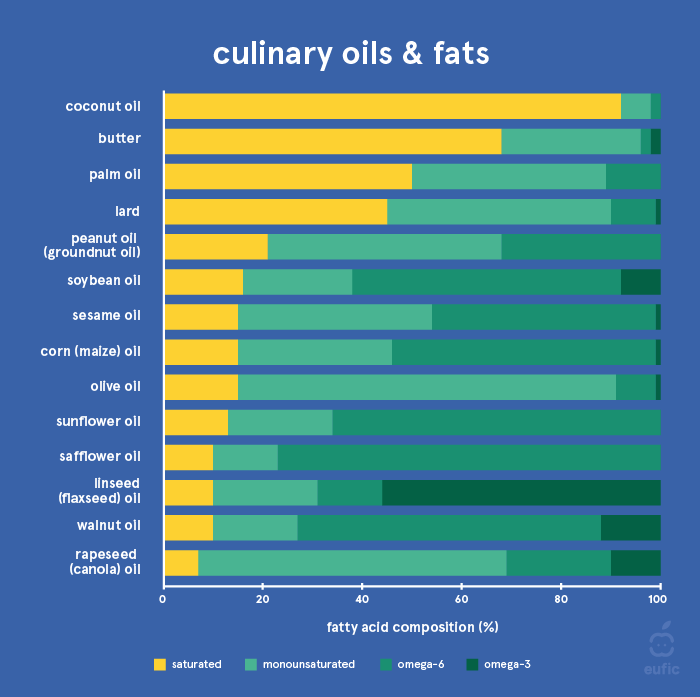Facts about Fats
Last Updated : 22 September 2015Fats are important for good health and proper functioning of the body. They are a source of energy, essential fats and enhance the absorption of fat soluble vitamins. However, too much fat and/or the wrong type of fat may negatively affect our health. Fats also give foods a particular texture, appearance and flavour. This article summarises the types of fats we eat, the foods in which they are found, their effect on our health, and the recommended consumption levels.
What are dietary fats?
Dietary fats are a macronutrient found in food. They belong to a larger group called lipids that also includes waxes, sterols and fat soluble vitamins.
What are the main types of fats and in which foods are they found?
Fats are triglycerides made up of a combination of different building blocks; glycerol and fatty acids. Depending on their structure, fats are classified as saturated or unsaturated (monounsaturated, polyunsaturated or trans).

Figure 1. Structure of a triglyceride and saturated, monounsaturated and polyunsaturated fatty acids.
Fats are found in most food groups and all foods generally provide a range of both saturated and unsaturated fats. The composition of fats in a particular food influences the physical and functional characteristics and has an impact on health. Foods that contain a high proportion of saturated fats, such as butter or lard, are solid at room temperature and are generally of animal origin. Foods that contain a high proportion of unsaturated fats, like vegetable oil and fish oil (containing omega-6 and omega-3 polyunsaturated fats respectively) are usually liquid at room temperature. However, some vegetable oils, such as palm or coconut oil, are relatively high in saturated fats and solid at room temperature.
The table below shows examples of foods that are high in fat, classified by the most prevalent type of fat they contain.
|
Typical foods |
Most prevalent type of fat |
|---|---|
|
High-fat cuts of red meat (beef, lamb, and pork), full-fat dairy products (such as butter, cheese, ice cream, milk and cream), palm oil, coconut oil and lard. |
Saturated |
|
Rapeseed oil, olives, sunflower seeds, sesame seeds, avocados, almonds, peanuts, hazelnuts and their oils. |
Monounsaturated |
|
Oily fish (like salmon, mackerel, herring, trout), rapeseed oil, soft fat spreads, walnuts, soybeans, flaxseeds (linseeds) and their oils. |
Omega-3 polyunsaturated |
|
Soft fat spreads, sunflower seeds, wheat germ, sesame seeds, walnuts, soybeans, corn and their oils. |
Omega-6 polyunsaturated |
|
Vegetable oils that have undergone a partial hydrogenation process* and are now present in products such as baked goods. Naturally present in milk, beef and lamb. |
Trans |
*Partially hydrogenated fat is declared on the food label list of ingredients

Figure 2. Fatty acid composition of common fats and oils.
Why should we eat fats?
Eating sufficient amounts of the right types of fats is important for a number of reasons. Dietary fats are a major source of energy for our bodies and are structural components of our body cells. The fat-soluble vitamins A, D, E and K cannot be absorbed by the body without the help of fats. Some fats (e.g. omega-3 and omega-6) are essential as the body cannot produce them and therefore need to be obtained through diet. They are needed for vital processes such as brain, eye and heart function, growth and development.

Figure 3. Functions of fats.
How much fat should we eat?
Adults should get a recommended 20-35% of their energy intake from fat. That means that a moderately active woman, with a daily energy intake of 2,000 kcal, should eat between 44 g and 78 g of fat per day. For men with a daily energy intake of 2,500 kcal, they should eat between 55 g and 97 g of fat per day. It is generally recommended that less than 10% of total energy intake should come from saturated fat, 22 g for women and 28 g for men. The rest should come from the unsaturated fats, monounsaturated and polyunsaturated. It is recommended that trans fats should be eaten as little as possible, and make up no more than 1% of total energy intake. This is equal to less than 2 g for women and less than 3 g for men.
Does eating fat make us fat?
Weight gain is not related to one single nutrient, but is based on the total daily energy intake and the balance between energy intake and energy use. Eating more calories than the body needs leads to the excess calories being stored as body fat regardless of the source of these calories (fat, protein or carbohydrate). It is the overall energy balance that counts.
However, fats are high in energy: 1 gram of fat contains 9 kcal – more than twice the calories of 1 gram of carbohydrate or protein (4 kcal/g each). Therefore, foods that contain a lot of fat provide relatively more energy when compared to low fat foods and we should be mindful not to overconsume these foods.
What are the health consequences of excess weight, obesity or eating too much fat?
Having obesity or excess weight puts you at an increased risk of chronic diseases, such as cardiovascular diseases, metabolic syndrome, type 2 diabetes and some types of cancers.
Generally, in addition to excessive calories, a high intake of fat can lead to a higher level of cholesterol and triglycerides in the blood. Certain types of fats also carry higher health risks than others. For example trans fat when consumed above the guidelines may contribute to a greater risk of developing cardiovascular disease. Recent studies also show that higher levels of saturated fat intake may not be associated with an increased risk of cardiovascular disease and type 2 diabetes. Still, cutting down on saturated fats and replacing them with unsaturated fats, especially polyunsaturated has been shown to potentially further reduce the risk of cardiovascular disease and improve brain function and vision.
How much fat do we actually eat?
Many Europeans exceed the recommended total fat intake, with maximum intakes ranging from 37% of total energy in the West, to 46% in the South. This makes the overconsumption of calories very likely and is best illustrated by levels of obesity in Europe.
Consumption of saturated fats exceeds the recommended maximum across Europe, while intake of unsaturated fats, both monounsaturated and polyunsaturated are lower than advised.
Recent actions to reduce trans fat by food reformulation have been successful. In Western Europe, consumption appears to be in line with the dietary recommendation of less than 1% of total energy intake with further reductions still to be achieved in some Eastern European countries.

Figure 4. Percentage of energy intake from total fat and saturated fat across European countries.1
How does the type of fat affect the properties of food?
Fats enhance texture, mouth-feel and appearance, and carry fat-soluble flavours. These characteristics are important in food production and cooking.
Unsaturated fats are generally less stable with greater sensitivity to heat, light and air. For simple domestic usage like shallow frying, baking, oils and spreads rich in monounsaturated and polyunsaturated fats are both suitable. In case of repeated use such as deep frying, it is advised to use oils with mainly monounsaturated oils, such as refined olive or peanut oil, as they are more stable and are safer to re-use than polyunsaturated oils such as corn or soybean oil.



